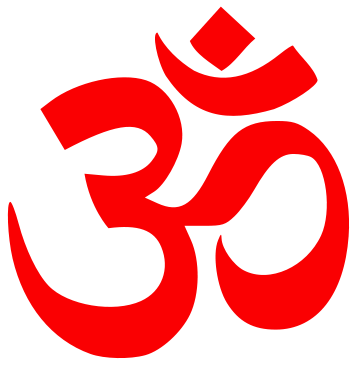The world appears dual, but this is a projection of the mind: this trick of Maya is also a function of our language: we see everything in terms of subjects and objects.
(An excerpt from From the Gita to the Grail: Exploring Yoga Stories and Western Myths by Bernie Clark. You can read the previous excerpt here.)
That is the nature of words and the nature of thoughts. To go beyond, to transcend this state of duality, we need to go within, and this is the advice of a tiny Upanishad called the Mandukya. Weighing in at a whole 12 lines, this has to be the most succinct explanation of illusion ever written. In it we learn about Aum, and about the nature of Brahman.
In the West we often see the word Aum written as “Om”—one syllable, two letters: this is a shorthand summary of the sound of the universe. Just as Jesus is God incarnate, and the Koran is God in-biblicate, Aum is God in-sonate.[i] “In the beginning was the Word,” and it was the Word that created the universe.[ii]
~
Saul kept us waiting, hanging onto every word. We were waiting in Down Dog, a rather challenging pose when held forever. Saul explained the original discovery by the earliest yogis of the magical word, Aum.
“Aum,” said Saul, “was discovered long ago when the very first yogi sat in a hot tub!” Among the modern sweating yogis there were a few laughs.
“Seriously!” he continued, “And you can re-discover Aum for yourself, the next time you step into a hot bath. The first sound that you will make is, “ahhhh.” After a few minutes soaking in the tub, you will say, “oooo.” After about five minutes you will say, “mmmm!” Finally, there will be silence.
~
Aum has four syllables and four distinct sounds: starting at the back of the throat is “ahhhh,” then the sound moves forward filling the cavity of the mouth with “ooooo,” then the humming vibration occurs when the lips are closed, “mmmmm.” Finally, there is the sound of silence. When the modern Western version of the word is chanted as “Om”—some sounds are missed: generally we will hear only two: the “ohhh” extending as longs as one’s lungs can last, and then a brief “mmmm.” Any silence is restricted to the time it takes to refill the lungs and blast out another round of sound.
Aum is the pranava, the boat that takes us to the yonder shore—beyond illusion and duality.[iii] In the Vedas the word Aum itself was never actually revealed; only euphemisms like pranava were used, because Aum is the ultimate power of the universe, and power must be guarded, kept secret.
The four syllables are symbolic: we can consider them as referring to the past (A), to the present (U), to the future (M), and to that place where time cannot flow (the silence)—the place before time began; before God said, “Let there be light;” before the Big Bang. In the Mandukya Upanishad the four syllables are pointers towards understanding truth. “A” represents the waking state of consciousness; “U” the state of dream consciousness; “M” the state of deep sleep consciousness; finally, the silence—the place beyond all definitions of consciousness—a place that can’t properly be named, but must be given a name so that we can converse, so this nameless state is simply called turiya: the fourth.
In our Western rational world, governed by Aristotelian logic, we believe that in our waking state we are more conscious of the world than when we are dreaming or in deep sleep. This waking state is the state of duality, and we think it is the highest state. It is in this state that I can say things like: “I am holding a water bottle with a Lululemon logo.” This is the realm of subjects (I) and objects (my water bottle.)
But consider this: imagine I am dreaming, and in my dream, I am holding my water bottle: now what is subject and where is the object? The dream me is holding a dream bottle: the difference between subject and object is not so distinct, but there is still the dreamer (subject) and the dream (object), so we have not yet transcended duality. Dream consciousness is the level of myths, for myths are from the same source and share the same energies as the dream world. But now, we go deeper, into deep dreamless sleep: there is no dream and no dreamer, so we are closer to reality, to having no subject and object, but there is still consciousness because if someone yelled, “Fire!” we would wake up and run out the door.
Where is your consciousness when you are deeply asleep? It is still there, but it is covered over by darkness, just dimly aware of the world. Go deeper, past sleeping consciousness to the fourth, the nameless state. To give it a name would be to make it an object; to say it is consciousness is to make it a subject; this state is beyond all words. The goal of Classical yoga is to go into this deepest state, awake: to remain conscious, but not conscious of anything because there are no objects to behold and no subject to do the beholding.
Similarly the goal in Vedanta and the teachings of the Upanishads is to be in this ultimate state of yoking your consciousness to reality, where you have transcended duality, and now you rest in brahman. This is the difference between Classical yoga’s purusha consciousness, which is forever separate from the world of prakriti, and the Vedantic view: since you went into this fourth state awake, you are still aware of the illusory world—you are still atman (the small self), who is aware that she is Brahman (the great self). You have not snuffed yourself out in nirvana, not yet, for you still remain embodied, but with this Vedantic realization you no longer have to come back and be reborn. For Vedanta followers, all is Brahman; all is one; and there is no place like Aum.
[i] See Joseph Campbell Audio Series One: Volume 1 – The Mystical Traditions of India; I.3.2 –4, “The Symbolism of AUM”, produced by the Joseph Campbell Foundation. [ii] John 1:1 [iii] Pra from prakriti means “nature” and nava, cognate with our English word navy, means “boat.” See The Shambhala Encyclopedia of Yoga ©1997 by Georg Feuerstein. (Shambhala Publications Inc.), 1997, page 225.
Love elephant and want to go steady?
Sign up for our (curated) daily and weekly newsletters!
Editor: Travis May
Image: Aum symbol

 Share on bsky
Share on bsky





Read 0 comments and reply